StATS: What is a conditional probability?
Conditional probability represents the chance that one event will occur
given that a second event has already occurred. Conditional probability
allows you to examine how different treatments or exposures influence the
probability of events like disease or mortality. It also provides a useful
way to evaluate diagnostic tests.
You can best understand understand conditional probability in the context
of a 2 by 2 table.
Definition of a 2 by 2 table.
Many of the variables that we encounter in medical research are binary.
That is, they have two possible values. Examples of binary variables are
alive/dead, diseased/healthy, male/female, treated/control.
A 2 by 2 table is listing of all the possible combinations for a
pair of binary variables. The data is laid out in a grid and the
numbers in the grid represent the number of occurrences of certain
combinations of the the two variables.
In the layout below, we list the variable X in the columns. We arbitrarily
label the two columns X+ and X-. We list the variable Y in the rows with
arbitrary labels Y+ and Y-.
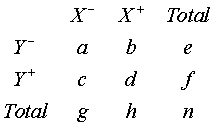
The values a through h and n represent the counts for various combinations
of X and Y. For example, "a" represents the number of times that X- and Y-
occur together, "e" represents the number of times that Y- occurs (regardless
of the value of X). n is the total number of events.
Example
In a study of breast feeding in pre-term infants, the infants were
randomized into two groups, an NG tube feeding group (treatment) and a bottle
fed group (control). The researchers wished to see if using the NG tube for
feeding rather than using a bottle would increase the likelihood of
breastfeeding at discharge and afterwards.
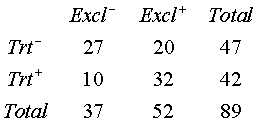
In the table below, the rows represent the feeding group (NG Tube versus
Bottle) and the columns represent feeding status at discharge (Exclusive
breast feeding versus Partial/No breast feeding). We see, for example, that
there are 20 exclusive breastfeeding controls.
Cell probabilities.
If we divide each entry in the table by n, the total sample size, we get
cell probabilities.
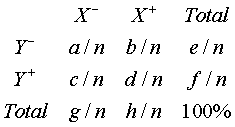
The probabilities in the total row/column represent unconditional
probabilities. The interior probabilities represent the probabilities of the
intersection between two events.
Example
Here is an example of cell probabilities, using the data presented above.
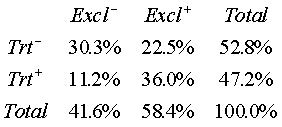
Notice that the (unconditional) probability that an infant was assigned to
the NG Tube group was 52.8%. The probability that an infant was assigned to
the Bottle group and was an exclusive breast feeder at discharge was 22.5%.
The probabilities in a table like this may not always add up because of
rounding.
Computing 2 by 2 tables in SPSS.
From the menus in SPSS, select ANALYZE | DESCRIPTIVE STATISTICS | CROSSTABS.
In the dialog box, insert the variables names in the ROW and COLUMN boxes.
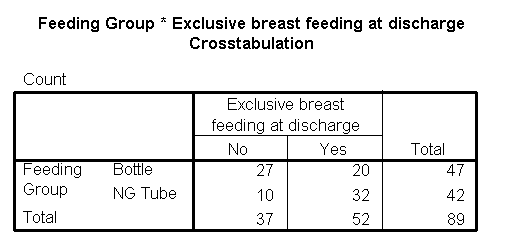
The table shown above is an example of the output using SPSS.
To compute cell probabilities in SPSS, click on the CELLS button in the
dialog box. This calls up a new dialog box. Check the box next to TOTAL
PROBABILITIES and uncheck the box next to OBSERVED.
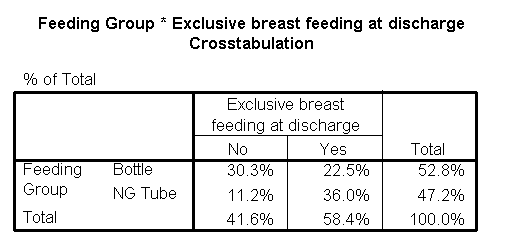
Listed above is an example of what the SPSS output would look like.
Conditional Probabilities.
Conditional probabilities represent the probability that an event will
occur when we restrict our attention to a specific row (or sometimes a
specific column) of a 2 by 2 table.
We use a vertical bar, "|" to denote conditional probability. The notation
![P[U|V]](images/cond13.gif)
is interpreted as the probability that U will occur given that V has
occurred. For example,
![P[Cancer|Smoking]](images/cond14.gif)
is the probability of developing lung cancer when we restrict our attention
to smokers only. We compute conditional probabilities by dividing by the row
totals (or sometimes the column totals).
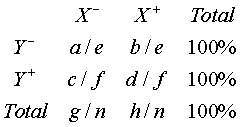
In the table shown above, we divide by the row totals. This answers the
question what is the probability of a certain value of X when Y is restricted
to a certain value.
![P[X+|Y+]=a/e.](images/cond15.gif)
![P[X-|Y+]=b/e.](images/cond16.gif)
![P[X+|Y-]=c/f.](images/cond17.gif)
![P[X-|Y-]=d/f.](images/cond18.gif)
The last row gives unconditional
probabilities. Unconditional probabilities represent probabilities without
any restrictions.
![P[X+]=g/n](images/cond19.gif)
![P[X-]=h/n.](images/cond20.gif)
Example
The following table gives probabilities for breast feeding status given the
feeding group that the inant was first assigned to.
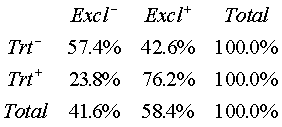
The probability of exclusive breast feeding when we restrict our attention
to the NG Tube group is 76.2%. When we restrict our attention instead to the
bottle fed group, the probability drops to 42.6%. The unconditional
probability of breast feeding is 58.4%, somewhere between the two conditional
probabilities.
Using SPSS to compute conditional probabilities.
You can get SPSS to compute conditional probabilities. As before, select
ANALYZE | DESCRIPTIVE STATISTICS | SUMMARIZE CROSSTABS from the menu. In the
dialog box, click on the CELLS button. Check the box next to ROW PERCENTAGES
to condition on the row categories. Check the box next to COLUMN PERCENTAGES
to condition instead on the column categories.
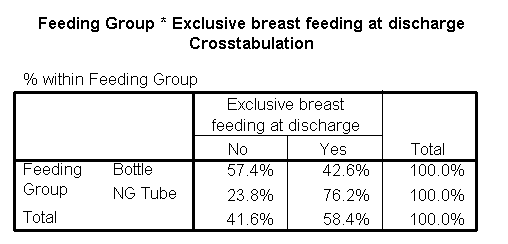
Shown above is an example of conditional probabilities using the breast
feeding study data.
A second example of conditional probability.
The data listed below is a study of infant mortality for white infants in
New York City in 1974. The infants are categorized by birth weight (low birth
weight is 2500 grams or less) and whether they survived for at least one
year.
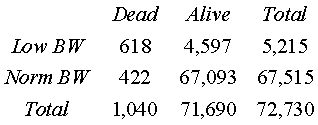
This table shows that the total sample size is 72,730 infants.
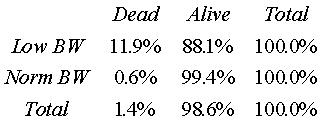
Notice that probability of survival is much higher among the normal birth
weight infants (99.4% compared to 88.1%).
Source: Fleiss JL. Statistical Methods for Rates and Proportions
(1981) New York N: John Wiley and Sons, Inc. page 77.
This page was written by
Steve Simon while working at Children's Mercy Hospital. Although I do not hold the copyright for this material, I am reproducing it here as a service, as it is no longer available on the Children's Mercy Hospital website. Need more
information? I have a page with general help
resources. You can also browse for pages similar to this one at Category: Definitions,
Category: Probability concepts.







![P[X+|Y+]=a/e.](images/cond15.gif)
![P[X-|Y+]=b/e.](images/cond16.gif)
![P[X+|Y-]=c/f.](images/cond17.gif)
![P[X-|Y-]=d/f.](images/cond18.gif)
![P[X+]=g/n](images/cond19.gif)
![P[X-]=h/n.](images/cond20.gif)



